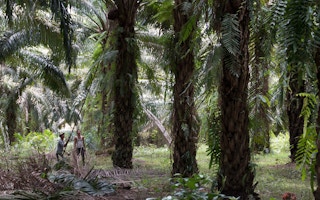The rate of deforestation in selective-logging concessions in parts of Indonesia has unexpectedly overtaken those of pulpwood and oil palm concessions, a new study shows.
A study by the NGO Forest Watch Indonesia (FWI) in the provinces of North Sumatra, East Kalimantan and North Maluku showed a combined loss of 7,180 square kilometers (2,770 square miles) of these forests between 2013 and 2016. Seventy-two percent of that deforestation occurred in areas under one of four types of concessions: selective logging (for timber); pulpwood (typically acacia, to make paper); oil palm; and mining.
Selective logging, which the researchers believed to be a declining industry relative to the booming oil palm and pulpwood industries, experienced the highest rate of deforestation over the study period, losing 838 square kilometers (323 square miles) of natural forest. This was followed closely by mining concessions (833 square kilometers), palm oil concessions (760 square kilometers) and pulpwood concessions (370 square kilometers).
“We considered the selective-logging industry to be comatose … largely replaced by acacia plantations and then oil palm plantations,” FWI campaigner Agung Ady Setiawan told Mongabay. But the study, he said, showed otherwise — and the culprit was the latter industry.
“
This pattern [of deforestation in HPH concessions] used to happen in Sumatra and Kalimantan [Indonesian Borneo] 10 to 20 years ago. Now it’s happening in HPH concessions in eastern Indonesia because this part of the country still has thick and lush forests.
Agung Ady Setiawan, campaigner, Forest Watch Indonesia
Selective-logging concessions, known by the Indonesian acronym HPH (Hak Pengusahaan Hutan), are the backbone of Indonesia’s historically important timber industry. But that industry has been on a steady decline due to competition from other countries across Southeast Asia and an export ban on unprocessed logs imposed by the government since 1985. (The ban was briefly lifted from 1997 to 2001, but has remained in place ever since.)
In 2000, selective-logging concessions occupied 640,000 square kilometers (247,100 square miles) of forested area in Indonesia, contributing $9 billion a year to the economy. By 2015, the concessions had shrunk by less than a third, to 206,200 square kilometers (79,600 square miles). Of the 269 selective-logging companies registered in the country, only 178 are still active.
Palm oil plantations, meanwhile, have experienced a boom in the past four decades, from just 3,000 square kilometers (1,160 square miles) of concessions in 1980 to 116,000 square kilometers (44,800 square miles) in 2016, according to the Indonesian Palm Oil Association (GAPKI).
Unlike acacia and oil palm plantations, the cutting of trees in HPH concessions is selective, with only commercially valuable trees larger than a certain diameter allowed to be felled. This leaves other trees standing for long-term generation. Between two and 20 trees are typically removed from each hectare of forest once every few decades.
This generally leaves more than 90 percent of the trees standing, and the remaining vegetation recognizably constitutes a forest.
That, said FWI’s Agung, was what made the discovery of the high rate of deforestation in selective-logging concessions such a surprise.
Upon closer inspection, FWI found that in many cases, the selective-logging concessions had been illegally converted into oil palm plantations, with the operators relying on a dearth or, in the case of abandoned concessions, complete lack of monitoring by the authorities.
This was the case in at least one of the selective-logging concessions studied in the district of South Tapanuli, in North Sumatra, said FWI researcher Mufti Fathul Barri.
“We assume that this is the cause of deforestation in some HPH concessions,” he said. “There are many HPH concessions that are left unmonitored and unmanaged by the owners, and so they’re converted into oil palm plantations by locals or other companies.”
The takeover by the oil palm plantations has also triggered conflicts with residents, the study found.
In other cases, the deforestation in HPH concessions was due to more trees being cut down than were permitted. FWI said this was the case in two selective-logging concessions in Obi Island, North Maluku. One of the concessions lost 48 square kilometers (18 square miles) of natural forest in the three-year study period, while the other lost 41 square kilometers (15 square miles).
“Based on our analysis, deforestation is shifting to the eastern part of the country,” which includes North Maluku, Agung said. “This pattern [of deforestation in HPH concessions] used to happen in Sumatra and Kalimantan [Indonesian Borneo] 10 to 20 years ago. Now it’s happening in HPH concessions in eastern Indonesia because this part of the country still has thick and lush forests.”
The government is considering once again lifting the ban on exports of unprocessed logs from HPH concessions, as a means of reviving the timber industry. It argues that with low domestic prices for timber, the industry needs access to the overseas market.
Environmental activists, however, warn that this will only speed up the rate of deforestation in selective-logging concessions.
“It’ll become deforestation permitted by law,” Even Sembiring, the policy assessment manager at Walhi, Indonesia’s largest environmental NGO, told Mongabay. “The protection of HPH concessions is still weak, as we can see from many former concessions being converted into oil palm plantations, because the managers don’t bother to reforest their concessions.”
This story was published with permission from Mongabay.com. Read the full story.










